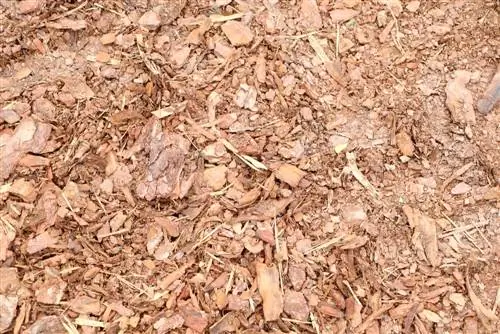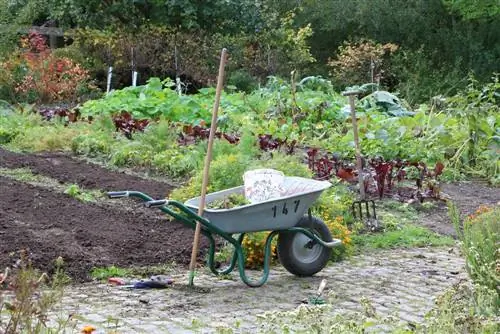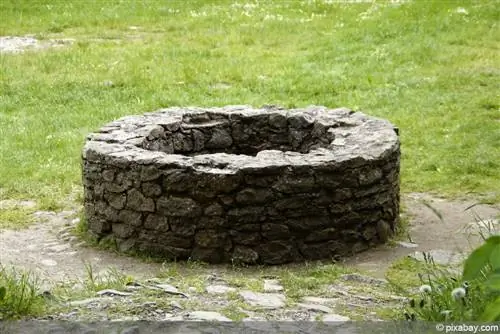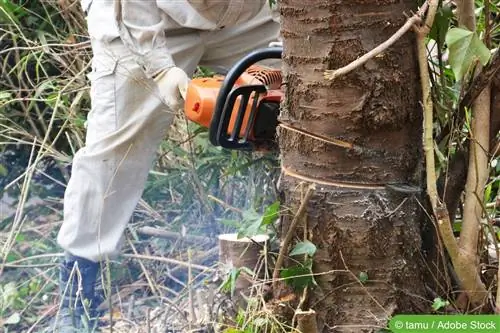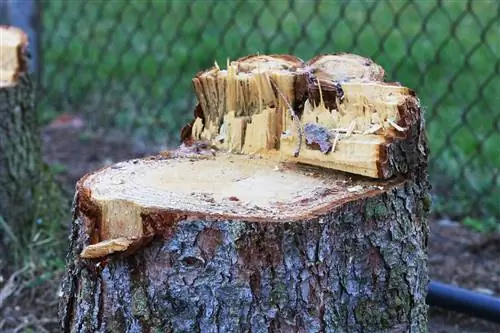- Author admin [email protected].
- Public 2023-12-17 03:39.
- Last modified 2025-01-24 12:45.
Trees are like the kings in your own garden. They are beautiful to look at, provide shade and sometimes also ensure a rich fruit harvest. However, sometimes a tree may need to be removed from the garden. Depending on the size, this can be a very difficult undertaking for which you definitely need professionals and possibly even a permit.
Reasons for tree felling
Although a tree is extremely robust and can grow very old, it is still not 100 percent immune to diseases, wind and weather. In fact, illnesses and storm damage are the most common reasons why a tree should or must be felled. Both can lead to the powerful plant quickly becoming a danger to life, limb and property. Cutting it down is not only advisable, but a must. And then there is also the fact that the tree has simply become too big. Anyone who has a 20 meter high spruce tree in the small garden of their single-family house, for example, often comes to the conclusion that the proportions here are fundamentally out of balance.
Note:
Cutting down a large tree is a highly complex and very dangerous matter. Anyone who is not a trained forest worker or forester should therefore stay away from it and rather hire a professional.
Tree removal
In our often densely built-up residential areas, tree felling is hardly possible anymore. The risk that the falling tree will cause significant damage is simply too great. In addition, even experts cannot always precisely predict in which direction a tree will fall. Your own house or neighbor's garden can quickly be affected. So it's not about felling a tree, but about removing it. Tree removal is when the tree is cut off piece by piece from above.
So you break it down into many small parts while it is still rooted in the ground. Of course, this is associated with less risk. But it is also clear that special equipment is required for this. One of the most important tools when removing a tree is a powerful, extremely high-extending lifting platform from which a specialist can remove the tree in small parts from above. So when people commonly talk about tree felling in a residential area, in most cases it is actually about tree removal.
Approval

If you have decided to remove a tree from your own garden, you first have to clarify whether you are even allowed to do so. For trees whose trunk circumference is at least 30 centimeters at a height of one meter, approval from the municipality or the lower nature conservation authority is definitely required. However, fruit trees that are actually cultivated are excluded from this.
For theperiod from March 1st to September 30th, an exemption is required,because birds nesting and breeding in trees should be particularly protected during this period. An exemption is usually only granted if the affected tree poses a specific danger, for example after storm damage. In order to obtain a permit, a corresponding application must be submitted to the municipality in advance. An on-site visit is often necessary to inspect the tree.
There is a fee for issuing the permit. The amount of the fees varies greatly from municipality to municipality and from federal state to federal state. For a simple permit they range between 25 and 90 euros. When it comes to an exemption, the range is between 80 and 130 euros.
Note:
Cutting down a tree without a permit is a misdemeanor which, under normal circumstances, is punishable by a fine.
Preliminary considerations
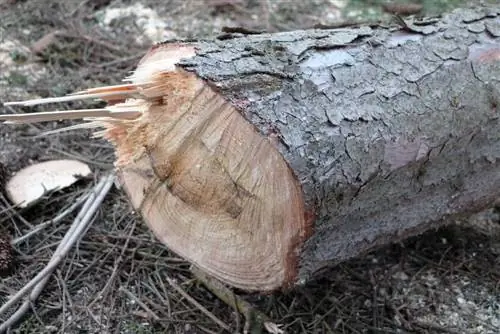
Once permission has been granted for tree felling or tree removal, a few questions need to be clarified. The most important thing is which company should carry out the removal. The best thing to do is to search for suitable companies on the Internet and then get binding offers from them.cost estimates. In order for these to be created and to be sustainable, an on-site visit is usually necessary. You should also have clarified the following questions:
- What should happen to the wood of the tree?
- Is this perhaps intended to be used as firewood?
- Who will cut it into small pieces?
- Who disposes of the green waste generated?
- Should the rootstock be removed or remain in the ground?
- Should the company remove it or do you do it yourself?
Tip:
As concrete answers as possible should be found to all of these questions, as these have an influence on the actual costs incurred.
Procedure
A tree removal usually follows a certain pattern. The contracted company will arrive with a truck, lifting platform, mini excavator, tools and safety material such as ropes. In addition, there are usually several employees, but at least two, on site.
In a first step, the area around the tree will be cordoned off. This is a safety zone that should not be entered because there is a risk that falling branches or other pieces of wood could cause injuries. Depending on the location of the tree, a public street or the neighbor's property may also be affected.
Once this has been secured, all branches of the tree are sawn off with a chainsaw. To do this, an employee drives up with the lifting platform and works his way up piece by piece.

Once all the branches have been removed, the trunk is also sawn off or removed from above in small units with a chainsaw. The individual elements may need to be roped down for safety reasons. The procedure continues until only a tree stump remains.
If the root needs to be removed, a mini excavator is usually used to expose it before it is also sawn up. Depending on your wishes, the wood is then either cut into firewood on site or loaded onto the truck for transport. The situation is similar with the resulting green waste.
Costs
The costs depend largely on the scope of the work to be done. They also differ significantly from company to company and from region to region. Providing concrete information about costs is therefore a difficult undertaking. The following list is average values that refer to the felling or removal of a tree with a height of 15 to 20 meters:
- Felling or removal: 200 to 500 euros
- Removal of tree stump and roots: 80 to 200 euros
- Rental fee for lifting platform: approx. 150 euros
- Cutting firewood: 50 to 100 euros
- Disposal of green waste: 100 to 150 euros
If you add the permit fee to these approximate figures, you get a total cost of 600 to 1,200 euros for a tree of this size.
Free alternative
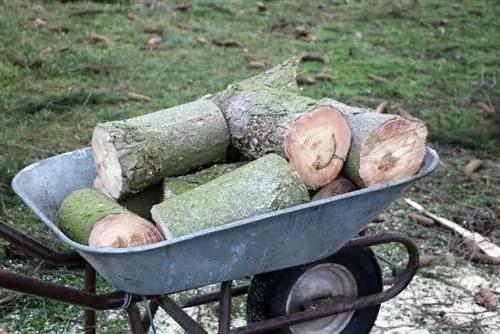
Since felling a tree always involves a relatively large amount of effort, there are hardly any cost-effective or even free alternatives. However, the costs can be reduced by taking on certain tasks yourself, such as cutting firewood, or by not removing tree stumps and roots. However, a firewood dealer may also be willing to cut down the tree free of charge if he receives the resulting wood and can then sell it.
You should also ask your local building yard or garden office whether the upcoming tree felling could be carried out as part of general maintenance measures. Carrying out the work yourself or on your own initiative would certainly be the most cost-effective option, but it is also by far the most dangerous.


